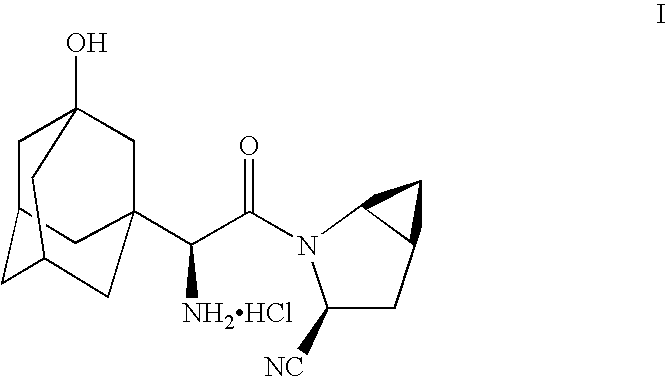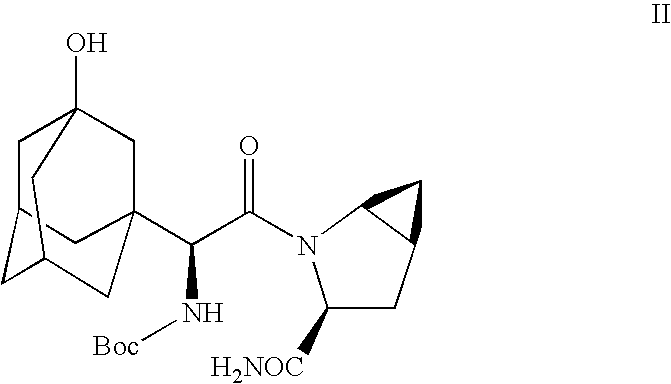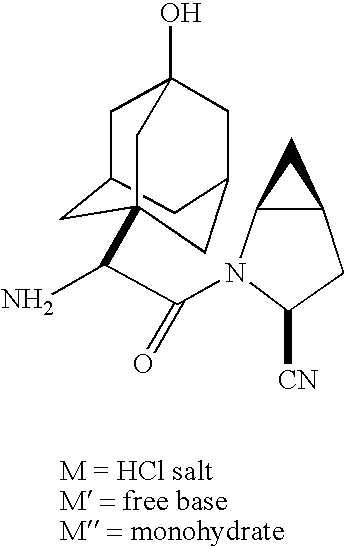Process for producing a dipeptidyl peptidase IV inhibitor
a technology of dipeptide and inhibitor, which is applied in the direction of biocide, heterocyclic compound active ingredients, organic chemistry, etc., can solve the problems of loss of yield, difficult to remove, and excessive degradation of exogenous peptide for continual therapeutic us
- Summary
- Abstract
- Description
- Claims
- Application Information
AI Technical Summary
Benefits of technology
Problems solved by technology
Method used
Image
Examples
example 1
3-Cyano-(3,7]dec-1-yl)-
[0046]A. BOC Protection of (3,7]decane-1-acetic acid (Formula IV) to form (3,7]decane-1-acetic acid, (V)
[0047](3,7]decane-1-acetic acid (Formula IV) (prepared as described in U.S. application Ser. No. 10 / 716,012, filed Nov. 18, 2003) (469 grams, 2.08 moles) was dissolved in ice cold 1 N NaOH (5 liters, 5 moles, 2.4 equivalents) in a phase splitter equipped with a temperature probe and a pH probe. THF (2.5 liters) was added to the solution. Solid Boc2O was then added and the reaction mixture was stirred at ambient temperature for approximately 1 hour. EtOAc (4 liters) was then added with stirring and the resulting organic and aqueous layers were separated. The pH of the aqueous layer was adjusted to 7 with concentrated HCl. EtOAc (4 liters) was then added and additional HCl was added to lower the pH to approximately 1. The total volume of concentrated HCl adde...
example 2
Preparation of Free Base Compound IB by Direct Dehydration of Example 1 Amide in a Single Pot
[0050]
[0051]Example 1 amide compound II (433 mg) was dissolved in dichloromethane (2 mL) and phosphorus oxychloride (306 mg, 0.183 mL, 2 equiv) was added to it at room temperature. The reaction mixture was stirred at room temperature for 2.5 h. HPLC of the reaction mixture suggested 3% of Example 1 amide compound II present in it. The reaction mixture was diluted with additional dichloromethane (2 mL) followed by the addition of phosphorus oxychloride (150 mg, 0.09 mL, 1 equiv). The reaction mixture was stirred at room temperature for an additional 1 h. HPLC showed the absence of Example 1 compound II in the reaction mixture.
[0052]The reaction mixture was cooled to +, 338 (M+Na)+, 356 (M+Na+H2O)+, 360 (M−H+2 Na)+, 436 (M+Na+H3PO4)+, 653 (2M+Na)+, 671 (2 M+Na+H2O)+. The retention time of this product by HPLC was similar to authentic sample of free base compound IB. 1H NMR and 13CMR were in ac...
PUM
| Property | Measurement | Unit |
|---|---|---|
| pH | aaaaa | aaaaa |
| temperature | aaaaa | aaaaa |
| total volume | aaaaa | aaaaa |
Abstract
Description
Claims
Application Information
 Login to View More
Login to View More - R&D
- Intellectual Property
- Life Sciences
- Materials
- Tech Scout
- Unparalleled Data Quality
- Higher Quality Content
- 60% Fewer Hallucinations
Browse by: Latest US Patents, China's latest patents, Technical Efficacy Thesaurus, Application Domain, Technology Topic, Popular Technical Reports.
© 2025 PatSnap. All rights reserved.Legal|Privacy policy|Modern Slavery Act Transparency Statement|Sitemap|About US| Contact US: help@patsnap.com



